The Wuerttemberg Museum of Psychiatry
The Wuerttemberg Museum of Psychiatry is a recent and expanding institution which is dedicated to studies on the history of German psychiatry with a focus on Wuerttemberg and, more recently, Baden. The first Wuerttemberg museum for the history of psychiatry and related fields has been established 2003, at Zwiefalten. Meanwhile, the Museum provides two sites: the first, being located on the premises of the oldest psychiatric clinic of Wuerttemberg, at Zwiefalten / Swabian Alb. The second location, an affiliation of the latter, is part of a permanent exhibition of “Staatliche Schlösser und Gärten Baden-Württemberg”, in the former monastery at Schussenried (Neues Kloster Schussenried), in Upper Swabia. The nucleus of the Zwiefalten Museum is a permanent exhibition on key aspects of Wuerttemberg psychiatric history including topics such as psychiatrists’ travels, art production by former patients, explanatory presentations of various forms of psychiatric therapies, the social history of life in the asylums etc. The Museum’s collection has continued to grow by purchase, gift, and transfer (particularly, in the latter case, by integrating the Collection of objects from Weinsberg Centre for Psychiatry).
This Museum regularly offers temporary exhibitions 2-3 times a year. Already presented projects included art exhibitions on paintings of former psychiatric patients, a photographic documentary on the 20th century psychiatry in Romania, portraits of life and work of former patients of the associated institutions who contributed to culture in and ‚outside the walls of the asylum’ (Bartlett and Wright) in various ways and forms. Further topics of temporary exhibitions deal with the ‚euthanasia’ in the NS-psychiatry or with the phenomenon of the patients´ photography from a medical-historical and photographic-historical point of view.
The Museum at Zwiefalten is located in a fin-de-siècle pathology building designed as a chapel at the grounds of Muensterklinik Zwiefalten in Southern Wuerttemberg, the follow-up institution of the first ‚Koeniglich-Wuerttembergische Staatsirrenanstalt’, founded in 1812 inside and around the architectural complex of a former Benedictine cloister (founded in 1089). The Museum is part of a larger medical network encompassing the whole of today’s Baden-Wuerttemberg Centres of Psychiatry including the historical archives and libraries of those.
The Zwiefalten Museum benefits from the active involvement of cultural scientists, historians of medicine, librarians, architects, psychiatrists and psychotherapists and the material support of Centres of Psychiatry in Wuerttemberg and Baden.
Both exhibitions show the development of psychiatry as medical science, also the placement and treatment, the everyday-life and destiny of the respected patients over a period of 200 years. The visitors are provided with clear, critical, but even for the medical non-experts understandable information on psychiatry, its successes, defeats and failures. The in-house research unit of the “ZfP Südwürttemberg” provides the rapid integration of current research findings and results into the exhibitions. Topics include the foundational processes of Wuerttemberg asylums in the 19th century, the development of these institutions, as well as more recent or contemporary aspects of psychiatric care and therapy. Museums are more than sheer spaces to collect objects or present the past: they contribute to shaping the future – and its concepts of medicine and health.
Further Information about the Wuerttemberg Museum of Psychiatry
Further information on the location and direction, history, opening hours of the museum as well as on photo galleries of the collection´s objects or on published historical studies of the associated publishing house “Psychiatrie und Geschichte” (“Psychiatry and History”) are to be found under
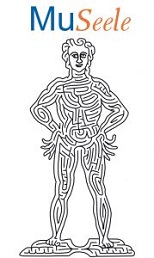
28.02.-01.03.2025
Conference of German-speaking psychiatry museums at MuSeele Göppingen
GÖPPINGEN - After long preparations, a very successful conference for German-speaking psychiatry museums took place from 28 February to 1 March 2025. A total of 18 institutions from all over the world (Bremen, Leipzig, Bern, Munich, etc.) came together. The conference programme consisted of intensive working sessions and a public lecture on the pioneer of psychotherapy Franz Anton Messmer by Prof. Dr. Knubben. The programme concluded with an excursion to Nürtingen to visit the art collection of the psychiatrist couple Greta and Ottomar Domnick.
MuSeele-Newsletter April 2025 (pdf)
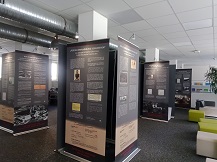
06.10.2024
Travelling exhibition “Psychiatry and National Socialism in the German Southwest using the example of Zwiefalten” has been in Stuttgart since the end of September.
STUTTGART - The new travelling exhibition “Psychiatry and National Socialism in the German southwest using the example of Zwiefalten 1933-1945” is also enjoying a high level of response and demand beyond the region. After Zwiefalten and Pfronstetten, it has been on display at the Baden-Wuerttemberg Cooperative State University in Stuttgart since 19 September and can be seen there until 4 November 2024. Further information on the exhibition can be found here and in the information flyer.
Flyer zur Wanderausstellung „Psychiatrie und Nationalsozialismus im deutschen Südwesten am Beispiel Zwiefaltens“ (PDF) >>
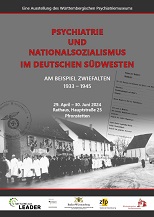
18.03.2024
Travelling exhibition „Psychiatry and National Socialism“ extended in Zwiefalten and from the end of April in 2024 in Pfronstetten
ZWIEFALTEN/PFRONSTETTEN - The new travelling exhibition „Psychiatry and National Socialism in the German Southwest using the example of Zwiefalten 1933-1945“ is in high demand.
The exhibition has been extended in the administrative building of the Centre for Psychiatry Suedwuerttemberg in Zwiefalten until 14 April 2024. From 29.04.2024 till 30.06.2024 it can be seen in the town hall in Pfronstetten (Reutlingen district, Baden-Wuerttemberg). This will be the first venue for the travelling exhibition after Zwiefalten. Further information on the exhibition can be found here and in the information flyer.
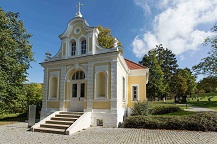
12.09.2023
Museum of the Centre for Psychiatry Suedwuerttemberg in the Museum Association of Baden-Wuerttemberg
ZWIEFALTEN - The Wuerttemberg Museum of Psychiatry is an integral part of museum culture in the state. Now it has been accepted into the Museum Association Baden-Wuerttemberg (Museumsverband Baden-Wuerttemberg).
The Wuerttemberg Museum of Psychiatry has been accepted into the Museum Association Baden-Wuerttemberg e.V. in its 20th year. Founded in 2003 at the Zwiefalten site, the museum of the Centre for Psychiatry Suedwuerttemberg now even has two locations: precisely at the site of Wuerttemberg's oldest psychiatric clinic in Zwiefalten, and as a psychiatric history room as part of the permanent exhibition "State Palaces and Gardens of Baden-Wuerttemberg" in the former Schussenried Monastery.
The permanent exhibitions show the development of psychiatry as a medical science and the accommodation and treatment of mentally ill people over a period of 200 years. The results of the work of Research Unit for the History and Ethics of Medicine at the Centre for Psychiatry Suedwuerttemberg make it possible to integrate current research into the existing exhibitions in a timely manner.
read more (pdf) >>
Further links:
Württembergisches Psychiatriemuseum Zwiefalten (forschung-bw.de)
Museumsverband Baden-Württemberg - Home (museumsverband-bw.de)
Lotto-Museumspreis | Lotto Baden-Württemberg (lotto-bw.de)
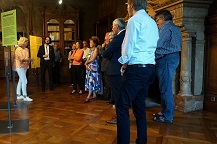
28.06.2023
Travelling exhibition of the Documentation Centre Oberer Kuhberg Ulm (DZOK) in the State Archives Sigmaringen
Dealing with anti-democratic and inhuman language „MAN WIRD JA WOHL NOCH SAGEN DÜRFEN“ („One dare say at least…“)
SIGMARINGEN - Verbally putting people down and attacking democracy was part of the essence of National Socialism. “Lügenpresse” (“lying press”), for example, was a fighting term that was on everyone's lips between 1933 and 1945 and is being used again today: in social media, in everyday life and in the politics of right-wing populist and extreme right-wing parties. The exhibition “Man wird ja wohl noch sagen darf..." (“One dare say at least…”) presents anti-democratic and inhuman terms from then and now; as well as actually neutral terms that can be used as weapons. The exhibition asks: What do these words mean? How were they used in the past and how are they used today? And what can be done against the poisonous effect of language?
The exhibition project at Sigmaringen State Archives is the result of a cooperation between the Centre for Psychiatry Suedwuerttemberg/Clinic for Psychiatry and Psychotherapy I of Ulm University Research Unit for the History of Medicine with the DZOK at Ulm. As a member of the working group “Places of the History of Democracy”, the State Archives of Baden-Württemberg and its affiliated state archives pursue the goal of promoting awareness of the history of German democracy and in this way stimulate democratic participation and the development of civil courage. By means of knowledge about the difficult paths to freedom and democracy, knowledge can be developed that can serve to recognise and combat threats to the basic democratic consensus.
Responsible for the exhibition: Dr. Nicola Wenge (DZOK Ulm), Prof. Dr. Thomas Müller, Dr. Bernd Reichelt (both Centre for Psychiatry Suedwuerttemberg / Clinic for Psychiatry and Psychotherapy I of Ulm University), Dr. Franz-Josef Ziwes (State Archives Sigmaringen).
The exhibition is open to the public from 28 June to 11 August 2023 on Tuesdays - Fridays from 9:30 am to 4:30 pm in the foyer of the Sigmaringen State Archives, Karlstraße 1 + 3, 72488 Sigmaringen. It is free of charge and freely accessible.
Links:
https://www.schwaebische.de/regional/sigmaringen/sigmaringen/man-wird-ja-wohl-noch-sagen-duerfen-1717055
https://www.landesarchiv-bw.de/de/aktuelles/ausstellungen/75643 bzw.
https://www.landesarchiv-bw.de/de/aktuelles/nachrichten/75655
Plakat zur Wanderausstellung „Man wird ja wohl noch sagen dürfen…“ (PDF)
Ausstellung im Staatsarchiv Sigmaringen (PDF)
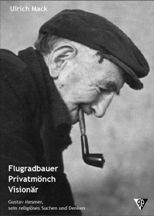
A workshop visit to Gustav Mesmer
New exhibition about unpublished photographs of Wuerttemberg „Patient-Artist“ Gustav Mesmer, participant at Sevilla World Expo 1992. The Wuerttemberg Museum of Psychiatry from June 28 to August 31, 2018 shows hitherto unpublished photographic material about one of the most known “patients” of psychiatry, also an artist in painting, constructing “flying bicycles”, inventing music instruments and many other inventions. The exhibition can be visited at the Centre for Psychiatry’s Central building at Ravensburg.
For more information (pdf) >>
Flyer (pdf) >>
Poster (pdf) >>
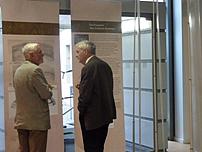

2-4 October 2015
Temporary exhibition about Korbinian Brodmann in Würzburg
With the exploration and presentation of the comparative localisation theory of the cerebral cortex at the beginning of the 20th century, neuroanatomist Korbinian Brodmann (1868-1918) left to medicine pioneering scientific discoveries. Within the framework of the 25th anniversary of the German Society for the History of Neurosciences (DGGN) in Würzburg (2-4 October 2015), the participants were informed on the life of Brodmann, his work and the resulting current developments in modern brain research, which were presented on the basis of this temporary exhibition. Korbinian Brodmann had studied medicine in Würzburg, Munich, Berlin and Freiburg and graduated in 1891. The exhibition was created by Dr Uta Kanis-Seyfried, a staff member of the Research Unit for the History and Ethics of Medicine at the Centre for Psychiatry Südwürttemberg, in cooperation with the Brodmann-Museum at Hohenfels-Liggerdorf. Dr Kanis-Seyfried has substantially expanded the exhibition at last.
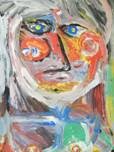
Art Exhibition – Preview in Bad Schussenried „Interpretations of the Spanish Girl“
The team of the Wurttemberg Museum of Psychiatry is very pleased to announce a very remarkable and interesting initiative within the framework of our 5th temporary exhibition in 2014. As part of our small preview, we open an art exhibition in the premises of the akademie südwest, New Cloister Bad Schussenried, on
Wednesday, 10 December 2014, 3:00 pm.
The art exhibition shows pictures from the competition initiated by the Department “Sheltered Home” of the Centre for Psychiatry Südwürttemberg in Ravensburg (Dr Michael Konrad) in cooperation with the Kunstmuseum Ravensburg (Dr Nicole Fritz). Both participants with psychiatric experience and school pupils from Ravensburg enriched this competition. The results of this drawing competition will be presented in the premises of our Academy, on the 1st floor of the New Cloister Schussenried.
Read more to the exhibition in German language >>
20. August 2015
„To achieve something extraordinary“. The Wuerttemberg Museum of Psychiatry received the award „EXTRA-Preis“ of the LOTTO of Baden-Wuerttemberg
The Wuerttemberg Museum of Psychiatry was chosen from a group of 117 applicants and received the prize “EXTRA-Preis” on 20 August 2015 which was awarded for the first time. According to the State Toto-Lotto GmbH of Baden-Wuerttemberg, “the high participation in the competition” was the reason for this prize, which will be also awarded in future besides the new prize “Lotto-Museum Prize of Baden-Wuerttemberg” presented for the first time as well. The seven-member jury of renowned cultural and museum experts acknowledged explicitly the “unusual concept for a rather bulky theme” and emphasized “the educational function of the museum”. The “EXTRA-Preis” should particularly appreciate the commitment of those museums, which “achieve extraordinary things in selected areas”. The Wuerttemberg Museum of Psychiatry was opened in 2003 near the Centre for Psychiatry Suedwuerttemberg in Zwiefalten, which is the place of foundation of the first “Royal Wuerttemberg State Mental Asylum” in 1812. This exhibition was extensively modernized between 2009 and 2011; the building was renovated in 2011. Dr. Uta Kanis-Seyfried and Priv.-Doz. Dr. Thomas Müller were responsible for the revision of the exhibition. In addition, a very successful initiative launched in 2010: the team of the Wuerttemberg Museum of Psychiatry under the leadership of Müller and Kanis-Seyfried designed a central museum space in the New Cloister Schussenried. After Winnenden (Winnenthal), Bad Schussenried was the third Wuerttemberg place, where the mentally ill could be treated since 1875. Another branch exhibition is planned in Ravensburg-Weissenau. The town council of Eschach, the city of Ravensburg and the museum of local history Eschach have approached the museum organizers now complemented by Dr. Bernd Reichelt. The prize money, but especially the appreciation on the part of the jury, prove the museum organizers were right. The competition result communicated to the winners in person unites different aspects of the work of the Museum of Psychiatry: the subject of a special appreciation was the occupation with the burdensome content like National Socialist history which became “more public” by the museum. The same concerns the remarkable integration of themes like the “Foster Care” which point to the importance of the family and society as part of the supply contract of psychiatric clinic beyond the historical institution walls and in historical perspective. The jury emphasized the self-established exhibition initiatives of the awarded museum, which have been formed in several places of the historical and current patient care. Not least, the creative conversion of a former pathology building of a psychiatric hospital to a museum site had a strong appeal. Meanwhile, temporary exhibitions take regularly place in this Zwiefalten museum.
